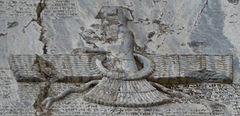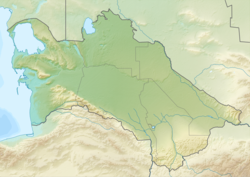مرو Marw | |
 Ruins of the city of Merv: the Great Kyz Kala.[1] | |
| Alternative name | Alexandria Antiochia in Margiana Marw al-Shāhijān |
|---|---|
| Region | Central Asia |
| Coordinates | 37°39′46″N 62°11′33″E / 37.66278°N 62.19250°E |
| Type | Settlement |
| History | |
| Abandoned | 1789 |
| Cultures | Persian, Buddhist, Arab, Seljuk, Mongol, Turkmen |
| Site notes | |
| Condition | In ruins |
| Official name | State Historical and Cultural Park "Ancient Merv" |
| Type | Cultural |
| Criteria | ii, iii |
| Designated | 1999 (23rd session) |
| Reference no. | 886 |
| Region | Asia-Pacific |
 |
| History of Greater Iran |
|---|
Merv (Turkmen: Merw, Мерв, مرو; Persian: مرو, romanized: Marv), also known as the Merve Oasis[citation needed],[a] was a major Iranian city in Central Asia, on the historical Silk Road, near today's Mary, Turkmenistan.[2] Human settlements on the site of Merv existed from the 3rd millennium BC until the 18th century AD. It changed hands repeatedly throughout history. Under the Achaemenid Empire, it was the center of the satrapy of Margiana. It was subsequently ruled by Hellenistic Kings, Parthians, Sasanians, Arabs, Ghaznavids, Seljuqs, Khwarazmians and Timurids, among others.
Merv was the capital city of several polities throughout its history. In the beginning of the 9th century, Merv was the seat of the caliph al-Ma'mun and the capital of the entire Islamic caliphate.[3] It served later as the seat of the Tahirid governors of Khorasan.[4] In the 11th–12th centuries, Merv was the capital of the Great Seljuk Empire and remained so until the latter's ultimate fall.[5][6][7] Around this time, Merv turned into a chief centre of Islamic science and culture, attracting as well as producing renowned poets, musicians, physicians, mathematicians and astronomers. The great Persian polymath Omar Khayyam, among others, spent a number of years working at the observatory in Merv. As Persian geographer and traveller al-Istakhri wrote of Merv: "Of all the countries of Iran, these people were noted for their talents and education." Arab geographer Yaqut al-Hamawi counted as many as 10 giant libraries in Merv, including one within a major mosque that contained 12,000 volumes.[8]
Merv was also a popular place for pilgrimage, and several religions considered it holy. In Zoroastrianism, Merv (Mouru) was one of 16 perfect lands created by god Ahura Mazda. Between the 5th and 11th centuries, Merv served as the seat of an East Syrian metropolitan province. A descendant of the Islamic prophet Muhammad, 8th Imam of Twelver Shia Islam, Ali ar-Ridha, moved to Merv from Baghdad and resided there for several years.[9] Al-Muqanna, the "Veiled Prophet", who gained many followers by claiming to be an incarnation of God, was born and started his movement in Merv.[10]
During the 12th and 13th centuries, Merv may have been the world's largest city, with a population of up to 500,000. During this period, Merv was known as "Marw al-Shāhijān" (Merv the Great), and frequently referred to as the "capital of the eastern Islamic world". According to geographer Yaqut al-Hamawi, the city and its structures were visible from a day's journey away. In 1221, the city opened its gates to an invading Mongol horde, resulting in massive devastation. Historical accounts contend that the entire population (including refugees) were killed; Tolui Khan is reputed to have slaughtered 700,000 people.[11][12][13] Though partly rebuilt after the Mongol destruction, the city never regained its former prosperity. Between 1788 and 1789, the city was razed by Shah Murad of the Emirate of Bukhara for the last time, and its population deported. By the 1800s, under pressure from the Russians, the area surrounding Merv was completely deserted.[14][8]
Today the site is preserved by the Government of Turkmenistan as the State Historical and Cultural Park "Ancient Merv". It was established in 1987 and is regulated by Turkmenistan's legislation. It is the oldest and most perfectly preserved of the oasis cities along the historical Silk Road in Central Asia. A few buildings and structures still stand today, especially those constructed in the last two millennia. UNESCO has listed the site of ancient Merv as a World Heritage Site.[15]
- ^ Williams, Tim; Campbell, Katie; Jorayev, Gaygysyz; Wordsworth, Paul; Jepbarov, Rejep; Moriset, Sébastien (5 December 2018). "Semi-fortified Palatial Complexes in Central Asia: New Work at the Great Kyz Kala, Merv, Turkmenistan". Archaeology International. 21 (1): 154. doi:10.5334/ai-395.
- ^ Yakubovskii, A.Yu.; Bosworth, C.E. (2007). Bosworth, Clifford Edmund (ed.). Historic Cities of the Islamic World. Brill. p. 401. ISBN 978-9004153882. Archived from the original on 13 July 2021. Retrieved 1 November 2020.
Merv, the conventional form of the Arabic Marw or Marw al-Shāhijān, an ancient city of the northeastern part of the Iranian world, in medieval Islamic times, in the province of Khurasan. The site of Merv now lies over the border from the Islamic Republic of Iran and within the Turkmen Republic, near the modern town of what was in Soviet times Mary. The form of the name Marw al-Shāhijān clearly related to the city's position in pre-Islamic and early Islamic times as the seat of the representatives of royal authority, the marzbāns of the East, and its role as a bastion of this part of the Iranian world as a bastion against barbarian pressure from the inner Asian steppes.
- ^ Sourdel, Dominique. "Al-Maʾmūn, Abbāsid caliph". Encyclopedia Britannica. Archived from the original on 7 June 2021. Retrieved 9 June 2021.
Al-Maʾmūn, having become caliph of the entire ʿAbbāsid empire, decided to continue to reside at Merv, assisted by his faithful Iranian vizier al-Faḍl.
- ^ Herrmann 1999, p. 33.
- ^ Starr, Frederick (2015). Lost Enlightenment. Central Asia's Golden Age from the Arab Conquest to Tamerlane. Princeton University Press. p. 425.
Sanjar's capital at Merv was not the ancient center around the ErkKala but a ...
- ^ Chandler, Tertius (2013). 3000 Years of Urban Growth. Elsevier Science. p. 232.
Hence under 125000 and probably under 100000—as Merv rose very fast as a Seljuk capital
- ^ Brummel, Paul (2005). Turkmenistan. Bradt Travel Guides. p. 7.
The Seljuks were to establish a mighty empire stretching right to the Mediterranean, with Merv as its capital.
- ^ a b Tharoor, Kanishk (12 August 2016). "Lost cities #5: how the magnificent city of Merv was razed – and never recovered". The Guardian. Archived from the original on 29 April 2021. Retrieved 18 March 2019.
- ^ "Why was Imam al-Reza (A.S.) Invited to Khurasan?". Imam Reza Network. Retrieved 3 July 2021.
- ^ Encyclopaedia of Islam, Vol. 7 (2nd ed.). Brill. 1993. p. 500.
- ^ Naimark, Norman (2017). Genocide A World History. Oxford University Press. p. 21. ISBN 9780199765263.
The city of Merv fell in February 1221 to Tolui, Genghis Khan's youngest son, who is said to have massacred 700,000 persons while sparing some eighty craftsmen.
- ^ Goldstein, Joshua (2011). Winning the War on War The Decline of Armed Conflict Worldwide. Penguin Publishing Group. pp. 45–63. ISBN 9781101549087.
- ^ Bonner, Jay (2017). Islamic Geometric Patterns Their Historical Development and Traditional Methods of Construction. Springer New York. p. 115. ISBN 9781441902177.
- ^ Herrmann 1999, pp. 122–123.
- ^ "State Historical and Cultural Park "Ancient Merv"". UNESCO. Archived from the original on 22 May 2019. Retrieved 19 February 2007.
Cite error: There are <ref group=lower-alpha> tags or {{efn}} templates on this page, but the references will not show without a {{reflist|group=lower-alpha}} template or {{notelist}} template (see the help page).

